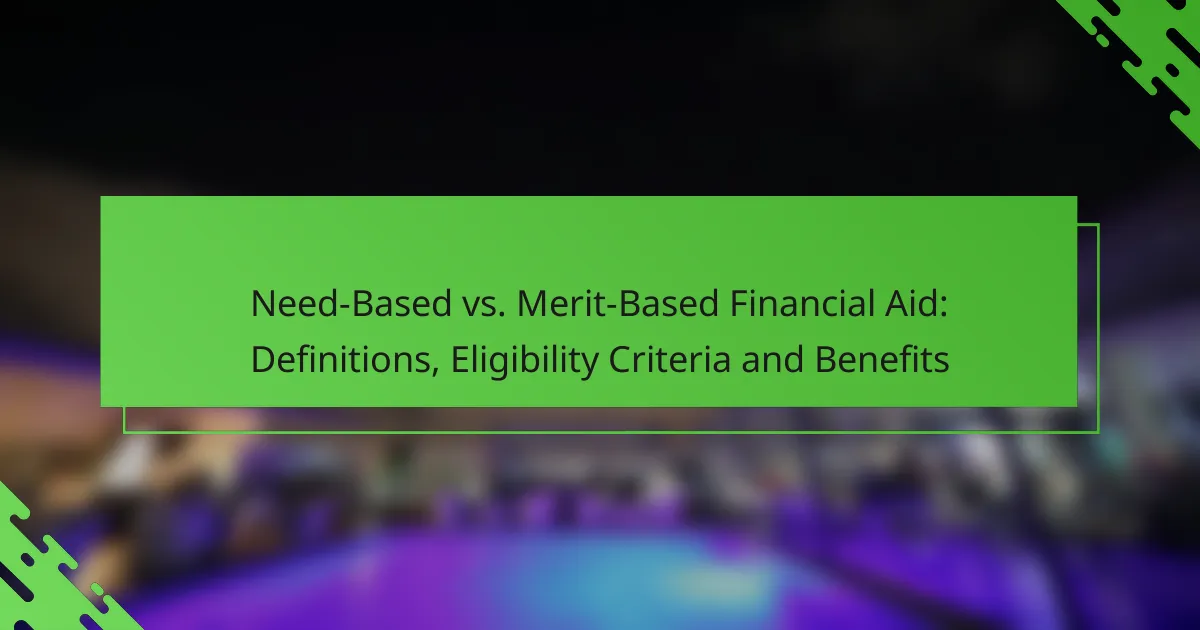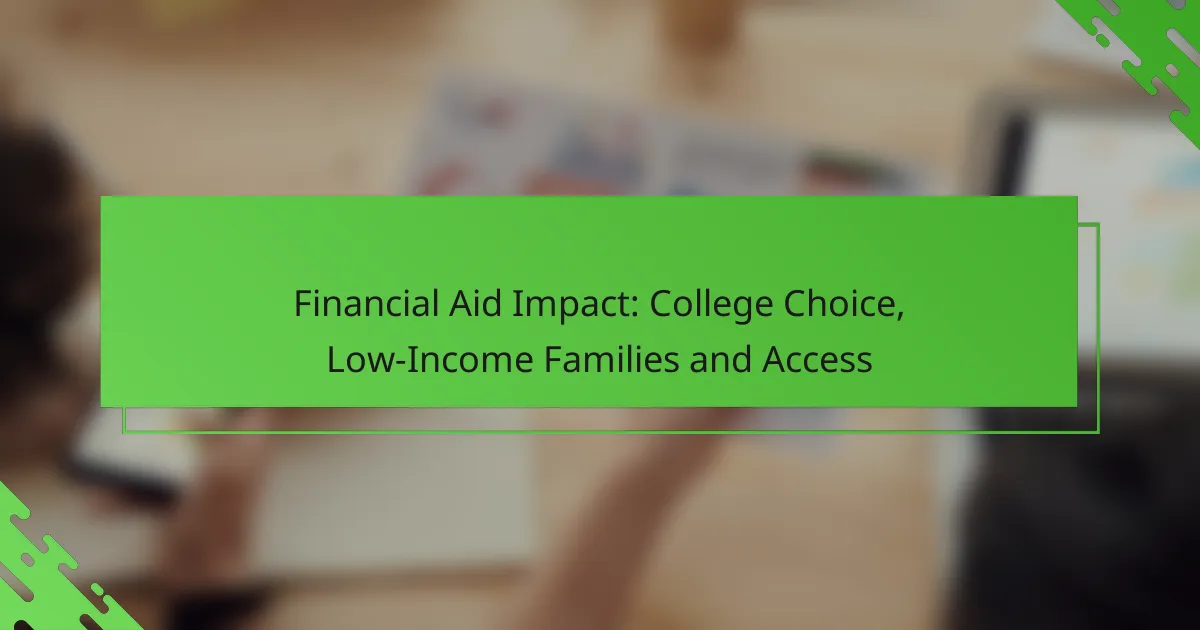What financial aid options are available in the United States?
In the United States, various financial aid options help students cover the costs of their education. These include grants, loans, scholarships, and work-study programs, each with distinct eligibility criteria and benefits.
Pell Grants
Pell Grants are federal funds awarded to low-income undergraduate students who demonstrate financial need. These grants do not require repayment, making them a valuable resource for those pursuing higher education.
The maximum Pell Grant amount can vary each academic year, but it typically ranges from a few thousand dollars to over six thousand dollars. Eligibility is determined through the Free Application for Federal Student Aid (FAFSA).
Federal Student Loans
Federal student loans are funds borrowed from the government to pay for education expenses, which must be repaid with interest. These loans generally offer lower interest rates and more flexible repayment options compared to private loans.
There are two main types of federal student loans: Direct Subsidized Loans, which are need-based and do not accrue interest while the student is in school, and Direct Unsubsidized Loans, which accrue interest from the time they are disbursed. Borrowers should carefully consider their repayment plans to avoid excessive debt.
State Grants
State grants are financial aid programs funded by individual states to assist residents in paying for college. Each state has its own eligibility requirements and application processes, often based on financial need or academic merit.
The amount of state grant funding can vary significantly, with some states offering several thousand dollars per year. Students should check with their state’s higher education agency for specific details on available grants and application deadlines.
Scholarships
Scholarships are funds awarded to students based on various criteria, such as academic achievement, athletic ability, or specific talents. Unlike loans, scholarships do not need to be repaid, making them an attractive option for funding education.
Scholarships can be offered by schools, private organizations, or community groups. Students are encouraged to research and apply for multiple scholarships to maximize their financial aid opportunities.
Work-Study Programs
Work-study programs provide students with part-time jobs to help pay for their education while gaining valuable work experience. These programs are typically funded by the federal government and are available to students who demonstrate financial need.
Students can earn money through work-study positions on or off campus, which can help cover living expenses and tuition. It is important to balance work hours with academic commitments to ensure success in both areas.
How do I apply for financial aid?
To apply for financial aid, you typically need to complete specific forms that assess your financial situation. This process often involves submitting the Free Application for Federal Student Aid (FAFSA), along with any state or institution-specific applications required for additional funding.
FAFSA Submission
The FAFSA is the primary form used to determine eligibility for federal financial aid in the United States. You can submit the FAFSA online, and it generally takes about 30 minutes to complete if you have your financial documents ready.
Make sure to submit your FAFSA by the deadlines, which can vary by state and institution. Early submission can increase your chances of receiving aid, as some funds are awarded on a first-come, first-served basis.
State Application Processes
Many states require additional applications for state-specific financial aid programs. These applications may be separate from the FAFSA and can include grants or scholarships that are only available to residents.
Check your state’s higher education agency website for details on deadlines and requirements. Some states have their own forms, while others may use the FAFSA data to determine eligibility.
Institution-Specific Applications
Some colleges and universities require their own financial aid applications in addition to the FAFSA. These forms often ask for more detailed information about your family’s financial situation and can be crucial for receiving institutional aid.
Be aware of the deadlines for these applications, as they can differ from federal and state deadlines. Institutions may also have specific criteria for their scholarships and grants, so review their financial aid webpage for guidance.
What are the eligibility requirements for financial aid?
Eligibility for financial aid typically depends on several factors, including income level, enrollment status, and academic performance. Understanding these requirements can help students maximize their chances of receiving assistance.
Income Level
Income level is a primary factor in determining financial aid eligibility. Most programs assess the family’s financial situation, often using the Free Application for Federal Student Aid (FAFSA) in the United States, which considers both income and assets.
Generally, lower-income families have a greater chance of qualifying for need-based aid. For example, families earning below a certain threshold, often in the low tens of thousands of dollars, may qualify for significant assistance.
Enrollment Status
Enrollment status refers to whether a student is attending school full-time or part-time. Full-time students typically have access to a wider range of financial aid options, including grants and scholarships, compared to part-time students.
Additionally, some financial aid programs require students to maintain a specific enrollment status throughout the academic year to remain eligible. Students should confirm the requirements of each program they apply for to avoid losing aid.
Academic Performance
Academic performance is another critical eligibility criterion for financial aid. Many scholarships and grants require students to maintain a minimum GPA, often around 2.0 to 3.0 on a 4.0 scale, to qualify for funding.
Students should strive to meet or exceed these academic standards, as falling below the required GPA can lead to losing financial aid. Regularly checking academic progress and seeking tutoring or support can help maintain eligibility.
What are the differences between grants and loans?
Grants and loans are both financial aid options, but they differ significantly in terms of repayment and funding sources. Grants are typically awarded based on financial need and do not require repayment, while loans must be repaid with interest over time.
Repayment Obligations
Grants do not have repayment obligations, making them a more favorable option for students seeking financial assistance. In contrast, loans require borrowers to repay the principal amount plus interest, which can vary based on the type of loan and lender. It’s essential to understand the repayment terms before accepting any loan, as some may offer deferment or income-driven repayment plans.
Funding Sources
Grants are often funded by federal or state governments, educational institutions, or private organizations, and are typically awarded based on financial need. Loans, however, can come from various sources, including federal programs, private banks, and credit unions. Federal loans usually offer lower interest rates and more flexible repayment options compared to private loans.
Eligibility Criteria
Eligibility for grants usually depends on financial need, which is assessed through the Free Application for Federal Student Aid (FAFSA) in the United States. Loans may have different criteria, including creditworthiness and enrollment status. Students should carefully review the requirements for each type of financial aid to determine their eligibility and maximize their funding opportunities.
How can I maximize my financial aid package?
To maximize your financial aid package, focus on researching available scholarships, negotiating aid offers, and maintaining good academic standing. Each of these strategies can significantly enhance your financial support for education.
Research Scholarships
Start by exploring various scholarship opportunities that align with your background, interests, and academic goals. Scholarships can come from schools, private organizations, and government programs, often covering a significant portion of tuition costs.
Utilize online scholarship databases and local community resources to find options that may not be widely advertised. Keep track of application deadlines and requirements to ensure you don’t miss out on potential funding.
Negotiate Aid Offers
If you receive multiple financial aid offers, consider negotiating with your preferred school to secure a better package. Present any competing offers you have received, as this can encourage the institution to increase your aid.
Be polite and professional in your communication, and clearly explain your financial situation and any special circumstances. Many schools have limited flexibility, but it’s worth asking for a review of your aid package.
Maintain Good Academic Standing
To ensure continued eligibility for financial aid, it is crucial to maintain good academic standing. This typically means achieving a minimum GPA, which can vary by institution but often falls around 2.0 to 3.0 on a 4.0 scale.
Stay informed about your school’s specific academic requirements for financial aid and seek academic support if you are struggling. Regularly check your progress and seek help from advisors to avoid jeopardizing your aid status.
What are the common misconceptions about financial aid?
Many people believe that financial aid is only available to those with low incomes, but this is not entirely true. Financial aid encompasses a variety of funding sources, including grants, scholarships, and loans, which can benefit students from different financial backgrounds.
Grants are only for low-income students
A common misconception is that grants are exclusively for low-income individuals. While many grants do target students with financial need, there are also numerous grants available based on academic merit, specific fields of study, or demographic factors.
For example, the National Science Foundation offers grants for students pursuing degrees in science, technology, engineering, and mathematics (STEM), regardless of their income level. Similarly, many private organizations provide grants to students based on their achievements or community service, not just their financial situation.
To maximize your chances of receiving grants, research various options and apply broadly. Keep in mind that some grants may have specific eligibility criteria, so carefully review the requirements before applying.





